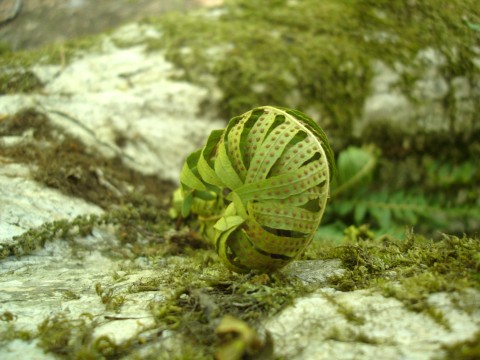| Polypodium fauriei | ||
Oshaguji-denda | ||
|
Etymology
Urbain Jean Faurie (1847-1915), a collector, mainly in eastern Asia, mainly of lichens, fungi.
Description
Rhizome: creeping, to 4 mm, dark brown, scales broadly ovate to ovate-lanceolate, 2--3 mm long, pale brown, clathrate.
Frond: 25 cm high by 8 cm wide, winter green, deciduous in summer, monomorphic, blade/stipe ratio: 3:1. Stipe: jointed at base, straw-colored, dark at base, circular in cross-section, glabrous, vascular bundles: 3. Blade: pinnatifid, ovate-lanceolate, pinnatifid, usually widest a bit above base, herbaceous to thinly papery, glabrous above, long, white hairs on the rachis and costa below. Pinnae: 15 to 25 pair, linear-lanceolate, moderately acute apex, 3--5 mm broad; margins minutely dentate; veins free, obscure, forking, not reaching the margin. Sori: round, discrete, half way between midrib and margin or somewhat closer to the midrib, absent from the last quarter of the pinna, indusium: absent, sporangia: yellow to brown at maturity; paraphyses absent. Dimensionality: when desiccated it rolls up lengthwise. Culture
Habitat: on mossy tree trunks and rocks.
Distribution: Japan, Korea.
Hardy to USDA Zone 7?.
Distinctive Characteristics
Three unique characters among the temperate Polypodium: long, white hairs on the rachis and costa, coiling of the fronds when dry, and the sori never reach the ends of the pinnae.
Synonyms
Polypodium japonicum (Franch. et Sav.) Maxon Polypodium vulgare var. japonicum Franch. & Sav. Compare with other species in the Eastern Asia Group
|
|
|
